Who doesn't know mallow? It is difficult to imagine a Ukrainian tyn or a Cossack front garden without a mallow. And even here, in the north, this is one of the favorite decorative flowering plants.
Bright and large flowers of mallow delight the eye for a long time in the garden, create a special, "country" or "country" mood. Summer is in full swing - the mallow blooms wildly in the garden ... Autumn is ahead - and the garden is decorated with tall candles covered with large mallow flowers ....
And what do we know about mallow? Tall (up to 2 or even sometimes up to 3 m in height) one-, two- or perennial herb with large pink or red flowers ... But it turns out that many completely different plants from this family are “hidden” under this name.
 | 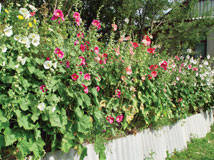 |
And many will be surprised that in fact - mallow, in the botanical sense, few people grow, and in our gardens grows mainly stock-rose, or hatyma, or mallow. And I think that many of our readers will even “be indignant”, confident that mallow is certainly growing in their gardens! However, as you know, "not all that glitters is gold." And this definitely applies to many mallow plants. The Malvaceae family unites about 70 genera, from 180 to 260 species. Many genera are very popular in our country as ornamental, and some are used as medicinal and dyeing plants.
The most popular mallow used as medicinal plants is Altey (Althaea). Althea officinalis (Althaea officinalis) has popular names: mallow, marshmallow, gulkhetmi, tukht, marshmallow grass, marshmallow root, kalachiki, mallow, povoinik, mucus, cat erysipelas, forest erysipelas, dog erysipelas, gingerbread, flatbread.
Perennial plant up to 150 cm high. Rhizome is short, multi-headed; fleshy, thickening slightly branched brownish smooth root. Leaves are alternate, long-petiolate, gray-green, cordate or ovate, dentate along the edge, soft-cloddy. The flowers are pale pink, five-petaled, located in the axils of the upper leaves at the top of the stems, forming spike-shaped inflorescences. The fruit is fractional, disintegrating into a significant number of unilocular fruitlets. The shape of the fruit is often reflected in the folk names of plants (kalachiki, flatbread, etc.). Blooms from June to September.
Distributed in the North Caucasus, the Volga region, in Eastern and Western Siberia. Grows in meadows, in damp places in river floodplains, sometimes forms thickets.
Roots are used as medicinal raw materials, less often leaves and flowers. The roots are harvested in autumn or spring from 2-3 year old plants. They have a peculiar weak odor, sweetish taste, slimy. Flowers and leaves are harvested during the initial flowering period.
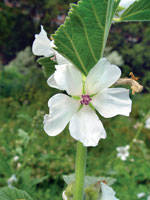 |
Marshmallow root is used as an expectorant, enveloping, emollient and anti-inflammatory agent for respiratory diseases: bronchitis, tracheitis, pneumonia, whooping cough, bronchial asthma. Infusion of marshmallow root is used for inflammation of the bladder, for chronic colitis and enterocolitis, accompanied by diarrhea, dysentery, dyspeptic diarrhea in children, kidney disease and especially gastric ulcer and duodenal ulcer. Effective for eczema, psoriasis.
Other species can be used, for example, marshmallow armenian(Althaea armeniaca)... Differs from marshmallow officinalis in denser gray-haired pubescence of the stem and leaves (above and below) and more dissected five-lobed middle leaves.
Marshmallow hemp(Althaea cannabina) with hard pubescence of the stem and leaves, up to 150 cm high. The leaves are alternate, with a long petiole, palmate-five-dissected with narrow lanceolate parts. The flowers are regular, single (or two) in the axils of the leaves. Petals are red, dark red at the base.
In ornamental horticulture, these species can be grown as a hedge, used as wings, giving a soft gray color to compositions.
Genus Mallow or Malva (Malva) - these are plants of the temperate zone of the European part, the Caucasus, Asia; almost 20 species are known within Russia. Differs from hautma (Lavatera) and stock-roses (Alcea), which are also often called "mallow", dissected leaves, notched flower petals.
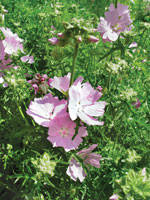 | 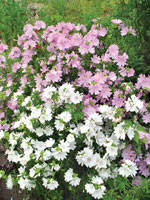 |
Perennial plants, up to 100 cm high, with an erect branched stem covered with hairs. Basal leaves are long-petiolate, oval-cordate and weakly lobed. Stem leaves on short petioles, lobed, pinnately dissected. Flowers on short stalks, located in the axils of the leaves one by one or in bunches of three. Corolla petals are triangular, up to 3 cm long, notched at the edges, pink, with dark veins. Fruits are capsules pubescent with hairs. Blooms from late June to late July.
Forest mallow (Malva sylvestris) has popular names: Zenziver's herb, royal curls, naked pannochka, mallow or marshmallow wild, marshmallows, forest marshmallow, red face, mucus, kalachiki.
Annual or biennial, 30–100 cm tall, with a fibrous root system, branched stem. The flowers are large, pink, with longitudinal red stripes, arranged in bunches in the leaf axils.
The infusion is used in folk medicine as an anti-inflammatory, enveloping and emollient for colds, inflammation of the digestive tract, as a mild laxative for diarrhea, externally - for burns, tumors, skin diseases, ulcers, sore throat, eye inflammation, hemorrhoids. The seeds are used as an anti-febrile substance, for pulmonary infections, as an emollient.
Musk mallow(Malva moschata L.) - slightly pubescent plant up to 80 cm tall. The flowers are large, pink, the veins do not stand out in contrast. Finger-dissected leaves.
It is almost not a demanding plant for soils, but on rich, humus, drained, non-acidic, sufficiently moist, but without close groundwater and stagnant water in the spring, it grows better. They are planted mainly in southern and sunny expositions. One of the main plants of country-style mixborders, so popular nowadays.
It is still rare in our gardens to find such a plant as Sidalcea (Sidalcea). These are perennial, rhizome plants from North America, 90-200 cm high, with an erect, weakly branched stem. Leaves are long-petiolate, palmate-separated. The flowers are pink, collected in an apical spicate inflorescence. The fruit is a capsule. Blooms from late July to September.
They are not demanding on soils, but on drained, rich, non-acidic, loamy, sufficiently moist soils, but without close groundwater and stagnant water in spring, soils grows better. They are planted mainly in southern and sunny expositions. Plants are winter-hardy and drought-resistant.
In joint plantings, it is combined with astilbe, cereals. In plantings, it behaves like a perennial.
Sidalese malvoflower(Sidalcea malviflora) - perennial up to 150 cm tall. Leaves are palmate-separated. The flowers are pink.
Sidalcea snow-white(Sidalcea candida) - perennial, up to 80 cm tall, leaves are pinnate-rounded, with 5-7 lobes. The flowers are white, up to 7 cm in diameter.
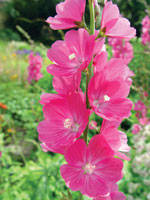 | 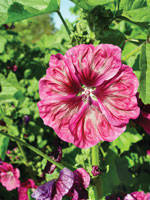 |
One of the most widespread in gardens plants from the Malvaceae family - Khatyma or Lavatera (Lavatera). Plants of the temperate zone, grow naturally in the Mediterranean, Asia, Australia, Africa. Up to 25 species are known, many garden varieties. Plants are one-, two- and perennial, herbaceous, rhizome. Stems are erect, up to 100 cm tall. The leaves are alternate, angular or 3-5-lobed, sometimes similar to maple leaves. The flowers are large, single or several in the axils of the leaves, form racemose-paniculate inflorescences. Corolla pink or purple, rarely yellow. The fruit is prefabricated. Seeds are reniform.
Unpretentious in culture. Photophilous, cold and drought resistant. However, it dies with excess moisture. Cannot be planted in areas with close groundwater. In regions with excessive moisture, it is best to grow on raised ridges.
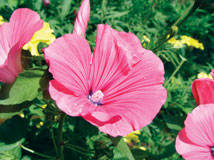 |
It does not need transplanting and rejuvenation for many years, plant transplantation is carried out only at a young age. They are planted in groups, on ridges, in mixborders. A must for country style groups.
Lavatera three-month (Lavatera trimestris) or a garden rose, - an annual, white or pink flowers, with red dark veins, a very spectacular plant in planting, especially old, tall, varieties. Modern varieties, which are usually no taller than 60 cm, should be planted in the foreground.
Lavatera Thuringian or dog rose(Lavatera thuringiaca) - a perennial herb, with shoots up to 2 m tall. Flowers up to 5 cm in diameter, pink, purple. It is very effective in mixborders made of large plants, as well as along fences or hedges, in single clumps on the lawn. The period of mass flowering is in July.
Stock-rose, or mallow (Alcea) originally from the Mediterranean, Anterior and Central Asia, Australia, Africa. Up to 60 species are known, many garden varieties.
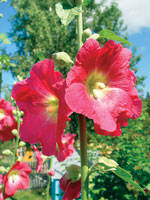 | 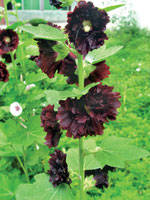 |
 | 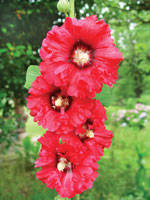 |
Plants are biennial or perennial. The root is long, taproot. Stems are erect, up to 2–2.5 m tall, pubescent. The leaves are alternate, rounded, 3-5-lobed, the lobes are shallow. The flowers are large, single or several in the axils of the bracts, form spike-shaped inflorescences. Corolla fivefold, various colors. The fruit is prefabricated. Seeds are reniform, rounded-reniform mericarps. Prolonged profuse flowering lasts from June-July until the first frost.
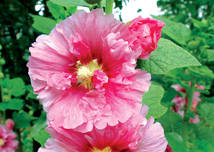 |
Seed propagation is preferable. In the south, they are sown directly into the ground in March or early April, in the north, seeds are sown for seedlings in February-March.
Grown in gardens as a biennial. In the first year, a rosette of leaves is formed, flowering begins in the second year. Unpretentious, but grows better on rich, deeply cultivated, non-acidic and well-fertilized soils. The plant is light-requiring, relatively cold-resistant, drought-resistant. During the flowering period, watering is required, but it is inhibited in growth and blooms poorly with an excess and stagnation of moisture in the soil. In plantings, it is combined with peonies, large hosts, daylilies (krasodnev). Plants must be protected from leaf-gnawing insects and fungal diseases (powdery mildew), which violate decorativeness.
Main varieties: black (Alcea rosea var.nigra) with velvety red-black simple flowers; semi-double (Alcea rosea var. Semiplena hort.) with flowers of various colors; terry (Alcea rosea f. Flore pleno hort.) - the most highly decorative, but also quite whimsical.
Flowers are used for medicinal purposes, less often roots. An aqueous decoction or infusion of flowers is used as a mucous, emollient, anti-inflammatory and astringent agent for gastrointestinal and respiratory diseases.
"Garden affairs" No. 9 (34), October 2009









